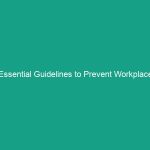Introduction
In today’s fast-paced business Environment, the importance of Health, Safety, and Environment (HSE) compliance cannot be overstated, especially for small businesses. Safety compliance for small businesses is not merely a legal obligation; it is a fundamental aspect of creating a sustainable and productive workplace. With limited resources, small businesses often face unique challenges when it comes to ensuring Workplace Safety, yet the Benefits of effective Safety Measures extend beyond mere compliance. They contribute to employee satisfaction, operational efficiency, and ultimately, the bottom line.
In this article, we will explore essential Safety compliance for small businesses, highlighting regulatory frameworks, best practices, challenges faced, and practical strategies to mitigate risks. We aim to provide a Comprehensive Guide that not only informs but also empowers small business owners to prioritize Safety in their operations.
Understanding Regulatory Frameworks
Compliance with health and safety Regulations is essential for any business, but navigating these regulations can be particularly daunting for small enterprises. In many countries, safety compliance for small businesses is guided by a combination of federal, state, and local laws. Understanding these regulations is critical for avoiding penalties and ensuring a safe work environment.
Key Regulations and Standards
Several key regulations govern Workplace Safety across various industries:
- Occupational Safety and Health Administration (OSHA): In the United States, osha sets and enforces standards to ensure safe and healthful working conditions. Small businesses must comply with OSHA regulations relevant to their specific industry.
- Environmental Protection Agency (EPA): The EPA regulates waste management and pollution Prevention, which can impact small businesses, especially those dealing with hazardous materials.
- Local Regulations: Many states and municipalities have additional safety regulations that small businesses must adhere to. It’s essential to stay informed about local laws.
Understanding Your Responsibilities
Small business owners have a legal obligation to provide a safe workplace. This includes conducting regular safety audits, providing adequate Training, and maintaining safety equipment. Failure to comply with these regulations can result in severe financial penalties and damage to your business reputation.
Best Practices for Safety Compliance
Implementing Best Practices for safety compliance is vital for mitigating risks and promoting a culture of safety within your organization. Here are some effective strategies:
Conducting Risk Assessments
One of the first steps in ensuring safety compliance for small businesses is conducting thorough risk assessments. This involves identifying potential Hazards in the workplace, evaluating the risks associated with those Hazards, and implementing Control Measures to mitigate them. Regularly reviewing and updating your risk assessments is crucial to adapt to any changes in operations or regulations.
Developing a Safety Plan
A comprehensive safety plan outlines the Procedures and policies necessary to maintain a safe work environment. This plan should include:
- Emergency response procedures
- Accident reporting protocols
- Employee training programs
- Regular safety drills
Ensuring that all employees are familiar with this plan is essential for its effectiveness.
Training Employees
Training is a critical component of safety compliance for small businesses. Employees should receive training on the specific hazards associated with their jobs, proper use of Personal Protective Equipment (PPE), and emergency procedures. Regular refresher courses should also be conducted to keep safety practices top-of-mind.
Case Studies: Successful Implementation of Safety Compliance
Examining real-world examples can provide valuable insights into effective safety compliance strategies for small businesses. Here are two case studies that highlight successful implementations:
Case Study 1: ABC Manufacturing
ABC Manufacturing, a small factory specializing in metal fabrication, faced challenges with workplace injuries and regulatory penalties. After conducting a comprehensive risk assessment, they identified key hazards such as machinery Operation and chemical exposure. The company implemented a safety plan that included:
- Regular safety training sessions for all employees
- Installation of safety guards on machinery
- Implementation of a safety reporting system
As a result, ABC Manufacturing saw a 40% reduction in workplace injuries over two years and received recognition for their commitment to safety compliance.
Case Study 2: XYZ Cleaning Services
XYZ Cleaning Services, a small cleaning business, struggled with ensuring the safety of their employees while working in various client locations. They developed a mobile safety training program that included:
- Online training modules accessible from any device
- Regular safety briefings before starting new contracts
- A buddy system for new employees to learn from experienced staff
Through these initiatives, XYZ Cleaning Services improved employee safety awareness, leading to increased employee retention and client satisfaction.
Challenges to Safety Compliance
While safety compliance for small businesses is essential, there are several challenges that owners may face:
Limited Resources
Small businesses often operate with tight budgets, making it difficult to allocate sufficient funds for safety initiatives. However, investing in safety can lead to long-term savings through reduced injuries and insurance costs. Creative solutions, such as leveraging online training resources and community partnerships, can help mitigate these challenges.
Employee Engagement
Another common challenge is ensuring employee engagement in safety practices. Workers may feel that Safety Measures are unnecessary or burdensome. To combat this, fostering a culture of safety where employees feel valued and involved in decision-making can significantly improve compliance. Regular feedback sessions and recognition programs can enhance motivation and commitment to safety protocols.
Future Trends in Safety Compliance
The landscape of safety compliance for small businesses is continually evolving. Here are some trends to watch for in the coming years:
Technology Integration
Advancements in technology are transforming how businesses approach safety compliance. From wearable safety devices that monitor employee health to software solutions for tracking compliance and incidents, technology can enhance safety practices and data collection.
Increased Focus on Mental Health
As awareness of mental health issues grows, small businesses are beginning to recognize the importance of mental well-being in the workplace. Employers are implementing programs that support mental health, which is an essential aspect of overall safety compliance.
Conclusion
In conclusion, safety compliance for small businesses is a critical element of operational success. By understanding regulatory frameworks, implementing Best Practices, learning from case studies, and addressing challenges, small business owners can create a safer workplace for their employees. As we look to the future, embracing technology and focusing on mental health will further enhance safety compliance efforts.
It is time for small business owners to prioritize safety and compliance, not only to meet legal obligations but to foster a culture that values the well-being of employees. By taking proactive steps now, you can avoid critical risks and ensure a thriving and safe business environment. Start by assessing your current safety practices and developing a comprehensive safety plan today!


